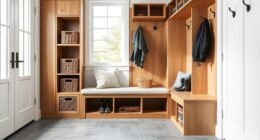Sliding doors are a smart choice if you want to save space, as they open horizontally without swinging into the room. This makes them perfect for tight spots, small closets, or rooms with limited clearance. Swing doors, on the other hand, require space to swing open, which can restrict furniture placement. To make the best decision for your needs and discover more tips, keep exploring how each option fits your space and style.
Key Takeaways
- Sliding doors do not require clearance to open, saving significant space compared to swing doors.
- Swing doors need room to swing outward or inward, limiting furniture placement and room layout options.
- Sliding doors are ideal for tight spaces, closets, or areas with limited room to maximize space efficiency.
- Swing doors require additional space for operation, which can restrict room flow in compact areas.
- Choosing sliding doors enhances space conservation and improves overall room functionality.

When choosing between sliding doors and swing doors, understanding their differences can help you make the best decision for your space. One of the key factors to contemplate is the cost comparison. Sliding doors typically have a higher upfront cost due to the materials and hardware involved, especially if you’re opting for high-quality glass or custom designs. However, their installation process can sometimes be more complex, which might add to the overall expense. Swing doors, on the other hand, are generally more affordable initially and easier to install. If you’re on a tight budget, swing doors could be the more economical choice, but keep in mind that their larger swing radius might require more space around them, potentially leading to higher costs if you need to rearrange your room or buy additional hardware.
Aesthetic appeal is another important aspect when choosing between these two options. Sliding doors offer a sleek, modern look that can enhance contemporary interiors. They often create a clean and minimalist aesthetic, especially if you choose frameless or flush-mounted designs. This can make your space feel more open and airy, which is particularly beneficial in smaller rooms or areas where visual flow matters. Sliding doors also tend to require less maintenance over time due to fewer moving parts compared to swing doors. Swing doors, by contrast, provide a classic, traditional appearance. They come in a variety of styles—from ornate wood finishes to simple, modern designs—allowing you to match your decor easily. Their presence can add warmth and character to a room, but they may also dominate the visual space more than sliding doors.
Beyond cost and style, think about how each door type interacts with your space. Sliding doors save significant space because they don’t require clearance to swing open. This makes them ideal for tight spots, closets, or rooms where every square foot counts. Swing doors need room to swing outward or inward, which can limit furniture placement or flow within a room. If space conservation is a priority, sliding doors definitely have the upper hand. However, if your room allows for ample clearance and you prefer a traditional look, swing doors can be a practical and attractive choice.
Ultimately, your decision should balance your budget, aesthetic preferences, and spatial needs. Sliding doors might cost more initially but provide a modern, unobtrusive look while saving space. Swing doors are usually more budget-friendly and offer a timeless appeal but require more room to operate comfortably. Considering door operation as an important factor can help ensure you select a style that aligns with your daily use and long-term satisfaction. By weighing these factors carefully, you’ll be able to choose the door style that best suits your lifestyle and design goals.
Frequently Asked Questions
Which Door Type Offers Better Insulation Properties?
Swing doors generally offer better insulation properties because they have tighter seals, enhancing thermal efficiency and soundproofing potential. You’ll find that swing doors can be fitted with weather stripping that minimizes drafts and noise. Sliding doors, on the other hand, often have gaps that reduce insulation effectiveness. If you prioritize energy savings and soundproofing, swing doors are the better choice for maintaining a comfortable, insulated space.
Are Sliding Doors More Secure Than Swing Doors?
Sliding doors aren’t inherently more secure than swing doors, but they can be just as safe with the right locking mechanisms. Think of them as a vault with a sturdy lock—if you choose high-quality locks and reinforce the track, your security concerns diminish. However, some may worry about potential vulnerabilities along the track. Ultimately, secure installation and robust locks make sliding doors as safe as traditional swing doors.
How Do Installation Costs Compare Between Sliding and Swing Doors?
You’ll find that installation costs for sliding doors often are higher than swing doors due to a more complex cost analysis. Sliding doors require specialized tracks and hardware, which can increase installation challenges and labor fees. Swing doors are usually simpler to install, making them more affordable upfront. However, consider long-term benefits like space-saving when weighing the overall value.
Which Door Type Requires Less Maintenance Over Time?
You’ll find that sliding doors generally require less maintenance over time because their hardware durability is higher, meaning fewer parts need replacing. They also operate more quietly, reducing operational noise compared to swing doors, which can creak or slam with frequent use. With proper care, sliding doors tend to stay smoother longer, making them a low-maintenance choice that keeps your space functional and quiet over the years.
Can Sliding or Swing Doors Be Customized for Different Aesthetics?
You can definitely customize sliding or swing doors to match your aesthetic. Think of it as a blank canvas—door material options like wood, glass, or metal let you set the tone, while customization styles range from modern to rustic. With a bit of creativity, you can tailor either door type to suit your space, making sure it reflects your personal style and fits seamlessly into your home’s overall look.
Conclusion
When choosing between sliding doors and swing doors, think of sliding doors as a river flowing smoothly, saving space and offering convenience. Swing doors are like a handshake—classic but sometimes bulky. If space is tight, sliding doors are your best bet, gliding effortlessly without swinging into your room. Ultimately, pick what fits your style and space best, and you’ll create a door that flows seamlessly into your home’s design, just like a well-choreographed dance.









